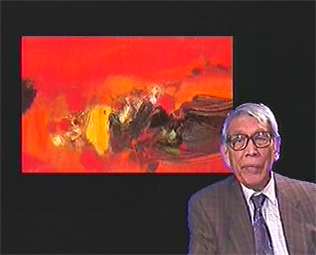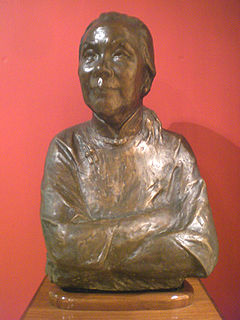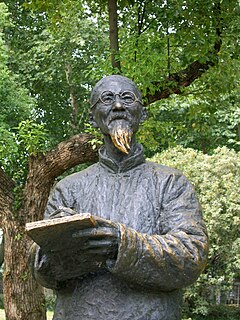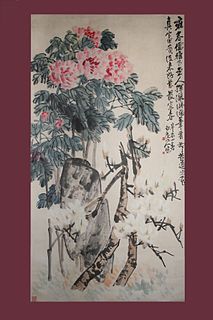 W
WChien-Ying Chang was a Chinese-born painter who settled in Britain in 1946.
 W
WChang Dai-chien or Zhang Daqian was one of the best-known and most prodigious Chinese artists of the twentieth century. Originally known as a guohua (traditionalist) painter, by the 1960s he was also renowned as a modern impressionist and expressionist painter. In addition, he is regarded as one of the most gifted master forgers of the twentieth century.
 W
WChen Shizeng, original name Chen Hengke, courtesy name Shizeng, art name Xiudaoren Xiuzhe, was a Chinese painter and critic, painter, and educator of early 20th-century China. At a time when some Chinese artists were rejecting traditional painting styles in favor of Western influenced styles, Chen championed traditional literati art in his own art and in his A Study of Chinese Literati Painting.
 W
WChu Teh-Chun or Zhu Dequn was a Chinese-French abstract painter acclaimed for his pioneering style integrating traditional Chinese painting techniques with Western abstract art. Chu Teh-Chun enrolled in the National School of Fine Arts, where he studied under Fang Ganmin and Wu Dayu. He was the first ethnic Chinese member of the Académie des Beaux-Arts of France, and together with Wu Guanzhong and Zao Wou-Ki were dubbed the "Three Musketeers" of modernist Chinese artists trained in China and France.
 W
WFang Ganmin was a Chinese French-trained painter, sculptor and educator, who was educated in Paris and spent most of his adult life in China. Regarded as one of the fathers of Chinese oil painting, Fang was born in the Wenling county, Zhejiang province. He began studying painting in 1924 and went to Paris in 1925, enrolling in the École nationale supérieure des Beaux-Arts, making him, along with Xu Beihong and Sanyu, one of the first Chinese painters to study abroad in France. Upon returning to China, he taught at the National Arts Academy, Hangzhou, becoming a professor at the Western Painting Department. During the Cultural Revolution, Fang was shamed and tortured by the Red Guards, and his works were destroyed. He died in 1984. His students include Zao Wou-Ki, Chu Teh-Chun and Wu Guanzhong.
 W
WFang Zhaoling, also known as Lydia Fong, was a Chinese painter and calligrapher.
 W
WFu Baoshi, or Fu Pao-Shih, (1904-1965) was a Chinese painter from Xinyu, Jiangxi Province. He went to Japan to study the History of Oriental Art in the Tokyo School of Fine Arts in 1933. He translated many books from Japanese and carried out his own research. In painting itself, he brought Japanese visual elements to the Chinese ink painting tradition.
 W
WGuan Pinghu, was a leading player of the guqin (古琴), a Chinese 7-string bridgeless zither. Born in Suzhou, Jiangsu, Guan came from an artistic family, and started to learn the guqin from his father, Guan Nianci. After the death of his father when he was thirteen, Guan continued with his father’s friend Ye Shimeng and Zhang Xiangtao. He also studied with the leading players of three different schools; Yang Zongji (1865–1933), the leading player in Beijing, the Daoist Qin Heming, and the Buddhist monk Wucheng.
 W
WGuan Zilan, also known as Violet Kwan, was a Chinese avant-garde painter. She was one of the first artists to introduce Fauvism to China, and was known for applying Western painting style to Chinese traditional subjects. Her most famous work is Portrait of Miss L. (1929). Although an art world favorite during the late 1920s and the 1930s, she stopped painting after the onset of the Cultural Revolution and became mostly forgotten in Communist China.
 W
WWu Cho Bun was an early 20th-century Chinese painter, famous for painting tigers.
 W
WHuang Baoyu was a Taiwanese artist, calligrapher and architect, known for designing the National Palace Museum in Taipei, Taiwan. His design for the museum was chosen after the original competition winner, Wang Da-hong, refused to modify his design to comply with the government's wishes. Huang specialised in the traditional Chinese palace style, and was the favourite architect of former leader, Chiang Kai-shek.
 W
WHuáng Bīnhóng was a Chinese literati painter and art historian born in Jinhua, Zhejiang province. His ancestral home was She County, Anhui province. He was the grandson of artist Huang Fengliu. He would later be associated with Shanghai and finally Hangzhou. He is considered one of the last innovators in the literati style of painting and is noted for his freehand landscapes.
 W
WJao Tsung-I or Rao Zongyi was a Hong Kong sinologist, calligrapher, historian and painter. A versatile and prolific scholar, he contributed to many fields of humanities, including history, archaeology, epigraphy, folklores, religion, art history, musicology, literature, and Near Eastern Studies. He published more than 100 books and about 1,000 academic articles over a career spanning more than 80 years.
 W
WLi Yanshan was a renowned Chinese guohua painter, calligraphist, poet, art educator and Chinese art connoisseur. He was also hailed as a master of guohua landscape painting.
 W
WLiang Xueqing (梁雪清), also known as Liang Hsüch-ch'ng, was the sister of three well-known Chinese painters and illustrators from the 1930s and 40s. She was an editor for the Wen Hwa (文华) or Culture Arts Review pictorial in the 1930s and was a rarity for promoting female painters in that era. She herself was a painter, from Guangdong, who gained some recognition in 1926, when her self-portrait was published on the front page of the Young Companion, issue 5, a prominent news and cultural pictorial, based in Shanghai and read internationally. She was the first painter on a Liangyou cover as well as the first female painter to be in the pictorial at all, making issue 2. She also had a painting published in issue 3, called Children's Music (儿乐). She painted with oil paints. and with watercolors. She was the author of the 1934 book 东北巨变血泪大画史 作者, about the war resisting the Japanese.
 W
WLin Fengmian, originally Lin Fengming (林凤鸣), was a Chinese painter and is considered a pioneer of modern Chinese painting for blending Chinese and Western styles, he was one of the earliest Chinese painters to study in Europe. He was also an important innovator in the area of Chinese art education. He was one of the pioneers of Chinese modern art, who earned the title of "The Four Great Academy Presidents".
 W
WLiu Kuo-sung is a Taiwanese artist based in Shanghai, China, and Taoyuan, Taiwan. Liu is widely regarded as one of the earliest and most important advocates and practitioners of modernist Chinese painting. He is also a writer on contemporary Chinese art.
 W
WLiu Haisu was a prominent twentieth-century Chinese painter and a noted art educator. He excelled in Chinese painting and oil painting. He was one of the four pioneers of Chinese modern art who earned the title of "The Four Great Academy Presidents".
 W
WLu Xiaoman was a beloved cultural figure in 20th century Chinese history. She was given the name of Mei, but later changed her name to Xiaoman. Although she was well known for her very passionate and public relationship with Xu Zhimo, she was a celebrated painter, writer, singer, and actor. She studied under painters such as Liu Haisu, Chen Banding (陈半丁), and He Tianjian.
 W
WNi Tian, born as Baotian, courtesy name Mogeng, sobriquet as Modaoren and Biyuehezhu, was a Chinese painter in Qing Dynasty and Republic Period.
 W
WOng Schan Tchow alias Yung Len Kwui was born in the ethnically Hokkien city in the eastern part of Longyan prefecture, Southern Fujian Province, China. He was well known for Chinese Ink wash painting and colour paintings of flowers, landscapes, animals, people, still life and Calligraphy. He was regarded as one of the first few batches of Chinese scholars and artists to study in Paris and one of the few artists who integrated both traditional Chinese and Western art techniques. During the Second Sino-Japanese War, he became renowned as a patriot artist when he exhibited extensively in China, Hong Kong and later in South East Asia to raise funds solely for the war relief effort and for the countless Chinese civilian victims in China, Malaysia and Singapore.
 W
WPan Tianshou was a Chinese painter and art educator.
 W
WPan Yuliang, born in Yangzhou as Chen Xiuqing, and was renamed Zhang Yuliang (張玉良) when adopted by her maternal uncle after the early passing of her parents. She was a Chinese painter, renowned as the first woman in the country to paint in the Western style. She had studied in Shanghai and Paris. Because her modernist works caused controversy and drew severe criticism in China during the 1930s, Pan returned to Paris in 1937 to live and work for the next 40 years. She taught at the École des Beaux Arts, won several awards for her work, had exhibits internationally in Europe, the United States and Japan, and was collected by major institutions. In 1985 after her death, much of her work was transported to China, collected by the National Art Museum in the capital of Beijing, the larger part are collected by the Anhui Museum in Hefei, the capital of Anhui Province. Nevertheless, significant paintings, sculptures and prints are still conserved in France in the collection of the Cernuschi museum. Her life as an artist has been portrayed in novels and film in China and the United States. Her art evolved within the flux of transformations where conflicting dichotomies of East and West, tradition and modernity, male chauvinism and emerging feminism co-existed. Pan is also figured as who engaged with labels, such as " contemporary/modern," " Chinese," and " woman" artist, while questioning them. Despite being remembered for introducing Western paintings to China, she was able to provide a new lens to how these women were seen through her paintings as not just objects but subjects.
 W
WLing Po was an artist and apprentice to Frank Lloyd Wright. Chow's English name "Ling Po" was coined by Wright by combining Chow's ancestral home Ningbo and the famous Chinese poet Li Bai.
 W
WPuru, also known as Pu Xinyu 溥心畬, Xinyu being his courtesy name, and Xishan Yishi 西山逸士, which is his sobriquet, was a traditional Chinese painter, calligrapher and nobleman. A member of the Manchu Aisin Gioro clan, the ruling house of the Qing dynasty, he was a cousin to Puyi, the last Emperor of China. It was speculated that Puru would have succeeded to the Chinese throne if Puyi and the Qing government were not overthrown after the 1911 Xinhai Revolution.
 W
WQigong was a renowned Chinese calligrapher, artist, painter, connoisseur and sinologist. He was an advisor for the September 3 Society, one of China's recognized political parties.
 W
WSitu Qiao was a Chinese oil painter and graphic artist. An important member of the Lingnan School of art, he was also known for his friendship with the influential writer Lu Xun. His most famous work is the 1940 painting Put Down Your Whip.
 W
WSun Duoci was a Chinese artist. Famous for her oil paintings, sketches and ink and wash works, she was an accomplished artist, as well as a calligrapher and writer. One of her pieces has sold at auction for more than $100,000. She was taught by the well-known artist Xu Beihong, who regarded her as a "painter of genius" and had an affair with him.
 W
WYuen Tsung Sze, known professionally as Mai-mai Sze, was a Chinese-American painter and writer. The Bollingen Foundation first published her translation of the Jieziyuan Huazhuan or The Mustard Seed Garden Manual of Painting with her commentary in 1956.
 W
WLi Tiefu was a Chinese painter, sculptor, calligrapher and revolutionary, known for introducing western oil painting to China and for assisting Sun Yat-sen in funding the Xinhai revolution and overthrowing the Qing Dynasty. During his time in New York, he was a member of the National Academy of Design. Li Tiefu was hailed as one of the most important Cantonese artists of the 20th century at the Guangdong Art Centennial Exhibition.
 W
WWang Zhen, commonly known by his courtesy name Wang Yiting, was a prominent businessman and celebrated modern Chinese artist of the Shanghai School. He also used the art name Bailong shanren and as a devote Buddhist under other names. He was originally from Wuxing in Zhejiang Province, although spent most of his life in the city of Shanghai where he was a successful businessman-banker. Wang Zhen was a master calligrapher as well as a painter of flowers, birds, personages and Buddhist subjects. He was closely associated with and considered the disciple of the painter Wu Changshuo. It is sometimes said that many of his teacher's paintings were from Wang Zhen himself.
 W
WWu Changshuo, born Wu Junqing, was a prominent painter, calligrapher and seal artist of the late Qing Period.
 W
WWu Guanzhong was a contemporary Chinese painter widely recognized as a founder of modern Chinese painting. He is considered to be one of the greatest contemporary Chinese painters. Wu's artworks had both Western and Eastern influences, such as the Western style of Fauvism and the Eastern style of Chinese calligraphy. Wu had painted various aspects of China, including much of its architecture, plants, animals, people, as well as many of its landscapes and waterscapes in a style reminiscent of the impressionist painters of the early 1900s. He was also a writer on contemporary Chinese art.
 W
WWu Zuoren was a Chinese painter. A native of Jing County, Anhui, he was born in Suzhou, Jiangsu Province. He practiced both traditional Chinese ink painting and European oil painting.
 W
WXu Beihong, also known as Ju Péon, was a Chinese painter.
 W
WYan Wenliang was a Chinese painter and educator, who is regarded as one of the fathers of Chinese oil painting and an important art educator of his time. Born in Suzhou, Jiangsu province, Yan began studying painting in 1909, founded the Suzhou Art Academy along with Zhu Shijie in 1922 and went to Paris in 1929, enrolling in the L'Ecole Superieure Nationale des Beaux Arts, making him, along with Xu Beihong and Sanyu, one of the earliest Chinese artists to study abroad in France. He was one of the four pioneers of Chinese modern art who earned the title of "The Four Great Academy Presidents".
 W
WZao Wou-Ki was a Chinese-French painter. He was a member of the Académie des Beaux-Arts in Paris. Zao Wou-Ki graduated from the China Academy of Art in Hangzhou, where he studied under Fang Ganmin and Wu Dayu.
 W
WZhu Shijie was a Chinese painter and educator, who is regarded as one of the fathers of Chinese oil painting and an important art educator of his time. Born in Suzhou, Jiangsu province, Zhu began studying painting in 1912 and founded the Suzhou Art Academy in 1922. In the 1920s, Zhu went to Japan and brought back to China the Bauhaus concepts and ideas of practical art. Zhu, along with Yan Wenliang and Hu Cuizhong comprise the “Three Masters of Suzhou”.